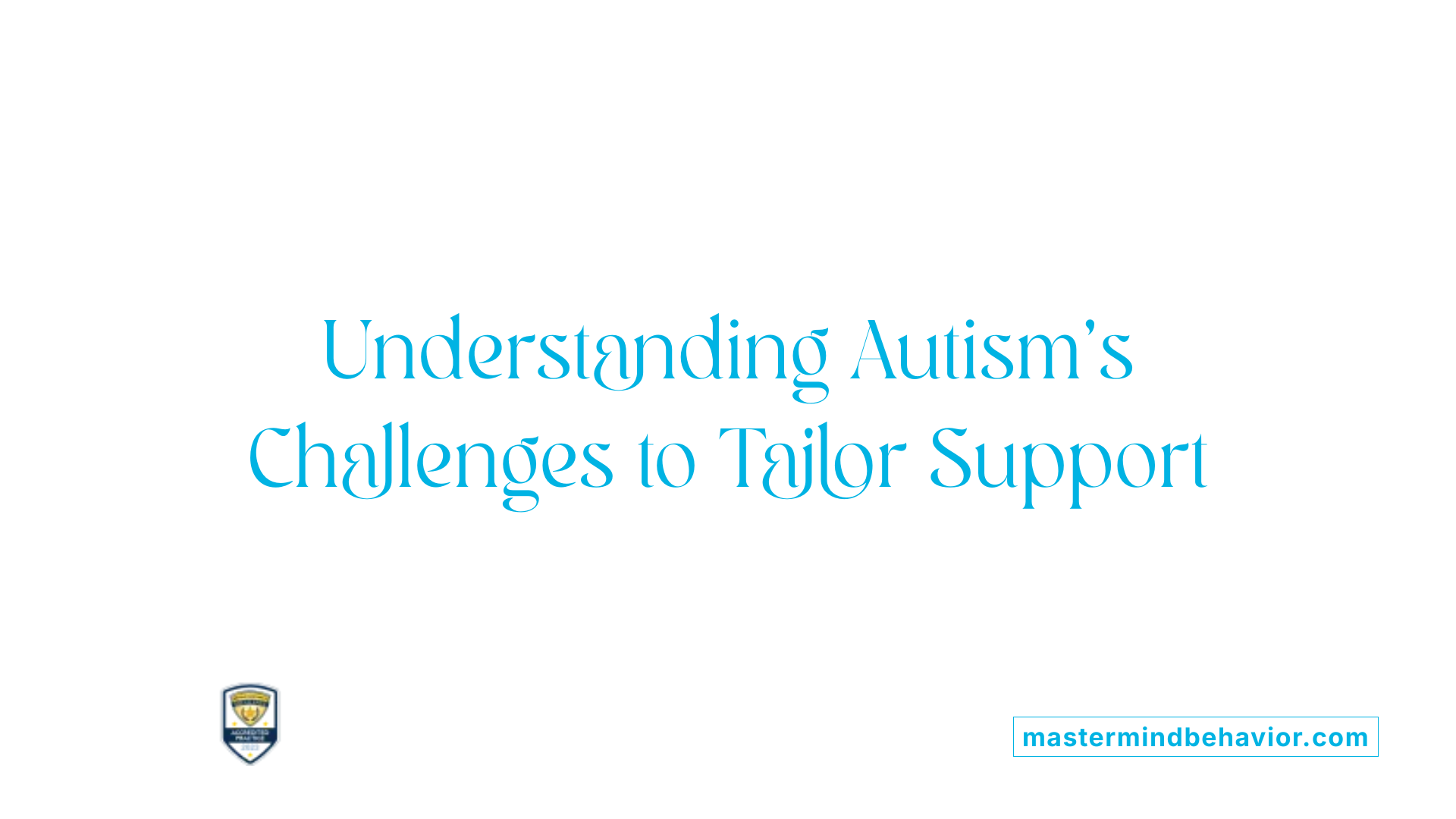Understanding the Significance of Autonomy in Autism Spectrum Disorder
Building independence in children with autism is a vital aspect of developmental growth, promoting self-confidence, social participation, and long-term well-being. This article explores effective strategies, key life skills, and the overall impact of fostering autonomy, emphasizing the importance of early intervention, tailored approaches, and community involvement to support children as they navigate their journey toward independence.
The Foundations and Benefits of Developing Independence in Children with Autism
Why is it important for children to develop independence?
Developing independence is vital for children with autism as it fosters self-confidence, boosts self-esteem, and reduces dependence on caregivers. When children learn to perform daily tasks and make decisions on their own, they gain a sense of control and competence. This not only enhances their emotional well-being but also prepares them for greater community participation.
Introducing routines like self-care, chores, or managing money gradually builds their skills and resilience. Visual supports, task breakdowns, and positive reinforcement are effective methods to teach these skills, making learning accessible and less overwhelming.
Long-term benefits including improved self-esteem, confidence, and community integration
Long-term, independent children are better equipped to navigate adult life. They are more likely to participate actively in community activities, hold jobs, and develop meaningful relationships. Building these skills from a young age creates a foundation for successful transitions into adolescence and adulthood.
Fostering independence also reduces parental stress and burnout, allowing families to enjoy a more balanced and positive relationship. Overall, encouraging independence supports children in becoming confident, capable, and emotionally resilient individuals.
| Aspect | Benefit | How It Is Supported |
|---|---|---|
| Self-care | Increased autonomy | Visual schedules, modeling, prompts |
| Household chores | Responsibility | Chore charts, task analysis |
| Money skills | Community participation | Real-world practice, visual aids |
| Safety skills | Secure navigation | Safety instructions, role-playing |
| Social skills | Better relationships | Role-playing, social stories |
Supporting independence is an ongoing process, tailored to each child’s abilities and interests. It leads to improved quality of life and opens opportunities for personal growth and social integration.
Core Strategies to Promote Independence and Skill Development

What are effective strategies to promote independence in children with autism?
Promoting independence in children with autism involves a multifaceted approach focused on developing essential life skills and supporting their ongoing growth. Key areas include teaching self-care routines, communication methods, household chores, financial literacy, and safety awareness.
Implementing visual supports such as schedules, checklists, and picture icons helps children understand daily routines and reduces anxiety. Structured routines foster predictability, making it easier for children to grasp expectations and take on responsibilities with confidence. Hands-on learning, combined with natural environment teaching—where skills are practiced within real-world contexts—ensures better generalization.
Assessments like the Community-Based Skills Assessment (CSA) allow educators and therapists to identify what skills children already possess and what areas need targeted support. This guides the creation of personalized intervention plans.
Community-based interventions, including social skills training and recreational activities, are vital for developing social competence and fostering community participation. Vocational training starting around age 14 prepares youth for employment, fostering independence through practical skill-building.
Supporting social and emotional development is equally important. Teaching children to regulate their emotions, ask for breaks, and respond to safety signals empowers them to navigate their environment more safely and confidently.
Collaboration with multidisciplinary professionals such as speech-language pathologists, occupational therapists, and educators ensures that interventions are tailored to each child's unique needs. This comprehensive approach, combining skill-building, community involvement, and continuous support, helps children with autism lead more independent, fulfilling lives.
| Strategy | Focus Area | Tools & Methods |
|---|---|---|
| Visual Supports | Routine understanding | Schedules, picture icons, timers |
| Structured Routines | Predictability | Consistent daily schedules, flexible routines |
| Hands-on Learning | Skill acquisition | Real-world practice, task analysis |
| Assessment Tools | Planning & evaluation | CSA, skill checklists |
| Community Engagement | Social skills | Group activities, peer support |
| Vocational Training | Employment prep | Job coaching, age-appropriate practice |
| Emotional & Safety Skills | Self-regulation | Social stories, safety rules, coping strategies |
| Professional Collaboration | Intervention consistency | Therapists, educators, caregivers |
Overall, the journey toward independence in children with autism is supported by a cohesive integration of targeted skill development, real-world experiences, and empathetic guidance tailored to each child's strengths and challenges.
Essential Life Skills for Supporting Autonomy in Daily Life

What are key life skills for children with autism?
Developing independence in children with autism involves teaching a variety of essential life skills that enable them to navigate daily routines confidently. These skills include self-care routines such as personal hygiene—brushing teeth, bathing, grooming—and dressing skills like putting on clothes. Establishing structured routines with visual supports, like checklists or pictorial guides, helps children learn and remember these activities, fostering autonomy.
Effective communication and social interaction are equally vital. Using augmentative and alternative communication (AAC) methods—including picture exchange systems (PECS), speech output devices, or sign language—allows children to express their needs, preferences, and feelings more effectively. This not only reduces frustration but also promotes meaningful engagement with peers and adults.
Safety awareness is fundamental for community integration. Children should learn safe behaviors such as crossing streets properly, recognizing safety signs, understanding emergency procedures, and using public transportation. Visual cues, practice in real-world settings, and community activities help reinforce these skills.
Skills related to household chores, money management, shopping, and transportation are crucial for fostering independence. Tasks like cleaning, making simple meals, handling cash, and navigating transit systems can be broken down into small steps using task analysis or supports like My Job Chart, which guides children through responsibilities and routines.
Finally, engaging in leisure and recreational activities tailored to their interests encourages social inclusion and recreational independence. Participating in community sports, clubs, or hobby groups helps children develop social skills, build friendships, and enjoy shared experiences.
Fostering these life skills involves personalized instruction, frequent practice, real-life application, and ongoing reinforcement, supporting children in achieving greater independence, confidence, and active participation in their daily lives.
Understanding Autism’s Impact on Independence and Development

How does autism affect independence?
Autism Spectrum Disorder (ASD) can significantly influence a person's ability to become independent. Children and adults with autism often face challenges in social communication, such as understanding social cues or expressing their needs clearly. These difficulties can make it hard to build relationships and navigate social environments on their own.
Executive functioning—skills like planning, organization, and problem-solving—may also be impaired in autism. This can lead to trouble with daily routines, managing time, or completing tasks without assistance. Moreover, adaptive skills, including self-care and household chores, might require ongoing support.
In addition to these core challenges, co-morbid conditions like anxiety, attention deficits (ADHD), and motor skills difficulties can further limit independence. For example, heightened anxiety might make transitions or unfamiliar tasks overwhelming, while motor coordination issues can impact self-care and mobility.
Despite these obstacles, many individuals with autism can develop various life skills. Early intervention, tailored support, and structured teaching methods—such as visual schedules, work systems, and social skill training—are vital. These strategies help children learn to manage their routines, communicate their needs, and participate in community activities.
However, the degree of independence varies widely. While some may achieve substantial autonomy, others might continue to require significant assistance into adulthood. Overall, autism's neurological features influence independence potential, but with personalized interventions and planning, positive outcomes and increased self-reliance are achievable.
Supporting Emotional and Social Needs to Foster Independence

Understanding the social and emotional needs related to independence?
Building independence in children with autism involves much more than teaching practical skills; it also requires addressing their emotional and social development. Central to this is establishing a sense of secure attachment and fostering emotional regulation. Secure attachment, formed through consistent, reliable caregiving, provides children with a feeling of safety that encourages exploration and resilience. Autistic children often have heightened sensitivities to changes and environmental stimuli, making dependable relationships vital for their confidence and ability to navigate the world.
Children's efforts to express their needs should always be validated as a part of healthy development. When children feel heard and understood, they develop trust and confidence, which are crucial for emotional independence. Trauma arising from early invalidation or harsh caregiving can hamper emotional health, leading to difficulties in trust, self-esteem, and regulation.
Recognizing children’s need for validation and connection
Validation and emotional connection serve as foundational elements in nurturing independence. When children’s attempts to communicate or express feelings are acknowledged positively, they learn that their needs matter. This validation helps foster secure bonds, which are especially important for autistic children who may struggle with social cues and communication.
By consistently engaging in empathetic interactions, caregivers can strengthen attachment bonds, creating a secure base from which children can confidently explore their environment and pursue independent activities.
Strategies for enhancing social skills and emotional competence
To support emotional and social development, various strategies are effective:
- Providing Emotional Connection: Regularly engaging in warm, responsive interactions helps build trust.
- Teaching Social Skills: Using social stories, role-playing, and modeling to teach conversation skills, sharing, and understanding others.
- Promoting Emotional Regulation: Implementing sensory regulation techniques, mindfulness, and coping strategies such as deep breathing or calming activities can help children manage overwhelming feelings.
- Supporting Problem-Solving and Decision-Making: Encouraging children to solve social dilemmas or make choices increases their confidence and independence.
By integrating these approaches, caregivers can create a supportive environment that nurtures a child's emotional well-being while gradually building their capacity for independence.
| Aspect | Approach | Benefits |
|---|---|---|
| Building attachment | Consistent caregiving, emotional availability | Promotes trust and resilience |
| Validating needs | Active listening, positive reinforcement | Fosters confidence and emotional security |
| Enhancing social skills | Role-playing, social stories, modeling | Improves communication and peer interactions |
| Developing emotional regulation | Sensory strategies, mindfulness, coping skills | Supports self-control and decision-making |
Supporting emotional and social needs is essential in guiding children with autism towards greater independence. Recognizing their unique sensitivities and strengths, and implementing targeted strategies, can significantly enhance their ability to manage emotions, connect with others, and succeed in everyday life.
The Role of Routine, Choice, and Reinforcement in Success

How do routines and reinforcement support independence?
Structured routines with visual supports and checklists play a vital role in fostering independence among children with autism. These routines help children understand what to expect throughout their day, reducing anxiety and making transitions smoother. Visual supports, such as schedules and checklists, provide clear guidance and serve as memory aids, enabling children to carry out tasks with less adult prompting.
Incorporating flexibility within routines allows children to adapt gradually to changes, building resilience and confidence. For example, visual schedules can include options, enabling children to select activities or tasks, which promotes their decision-making skills.
Empowering children through choices is another important aspect. When children are given opportunities to decide what to wear, what activity to do, or what snack to choose, they develop a sense of control over their environment. This autonomy supports their motivation and encourages independent problem-solving.
Positive reinforcement is essential for encouraging new and existing skills. Strategies such as praise, reflection, imitation, and description strengthen desired behaviors. Using rewards or privileges when children successfully complete tasks reinforces their efforts and promotes continued practice.
Reinforcing independence with rewards not only boosts motivation but also fosters a sense of achievement. Over time, children internalize these positive associations, making independent behaviors more natural and spontaneous. This combination of structured routines, choices, and reinforcement supports children with autism in developing greater self-reliance and competence.
Creating a Supportive Environment and Encouraging Lifelong Growth

How can assistive technology and visual supports aid children with autism?
Assistive technology and visual supports play a crucial role in fostering independence for children with autism. Communication devices such as speech output tools, picture exchange systems (PECS), and visual schedules help children express their needs and manage routines more effectively. Visual supports like checklists, timers, and sensory aids provide clarity, reduce anxiety, and promote understanding of daily tasks. By working closely with professionals such as speech and occupational therapists, caregivers can customize these tools to suit each child's abilities, encouraging greater participation and self-reliance.
Why is patience and celebration important in fostering independence?
Patience and celebration are essential ingredients in nurturing independence. Recognizing even small achievements helps boost a child's confidence and motivates continued effort. Celebrating milestones, such as completing a chore or mastering a new self-care skill, reinforces positive behavior and self-esteem.
At the same time, patience allows children to learn at their own pace without feeling pressured. It creates a supportive atmosphere where mistakes are viewed as part of growth, not setbacks. Supporting parents and caregivers by encouraging patience and celebrating progress can make a significant difference in the child's emotional well-being and willingness to try new tasks.
How can we support parents and caregivers’ well-being?
Supporting the well-being of parents and caregivers is vital for maintaining a positive environment for the child. Providing educational resources, respite care options, and support groups helps reduce stress and prevent burnout. Encouraging caregivers to take care of their mental health enables them to stay patient and consistent in their support.
Furthermore, strategies such as sharing successes, setting realistic goals, and practicing self-compassion promote resilience among caregivers. When caregivers feel supported and valued, they are better equipped to foster a nurturing environment that encourages children’s lifelong growth.
Fostering a Brighter Future Through Independent Living
Supporting independence in children with autism is a comprehensive, ongoing process that involves tailored skill development, emotional support, routine, and community engagement. Early intervention, patience, and collaboration among families, professionals, and the community create a nurturing environment. This approach not only cultivates essential life skills but also enhances self-reliance, confidence, and emotional resilience, ultimately paving the way for a more inclusive and empowered future for children with autism.
References
- Ten Ways to Build Independence | Autism Speaks
- Why “Independence” Is a Loaded Concept – and the Critical Role ...
- I Can Do It Myself Using Work Systems to Build Independence: Articles
- Achieving Independence and Mastery in School: An Open Trial in ...
- Promoting Independence in a Child with Autism
- Empowering Autistic Children Toward Independence: Key Daily ...
- Encouraging Independence in Children with Autism - Childwise ABA
- How to Build Independence in Preschoolers - Child Mind Institute
- Building Independence - Pathways of Resilience










